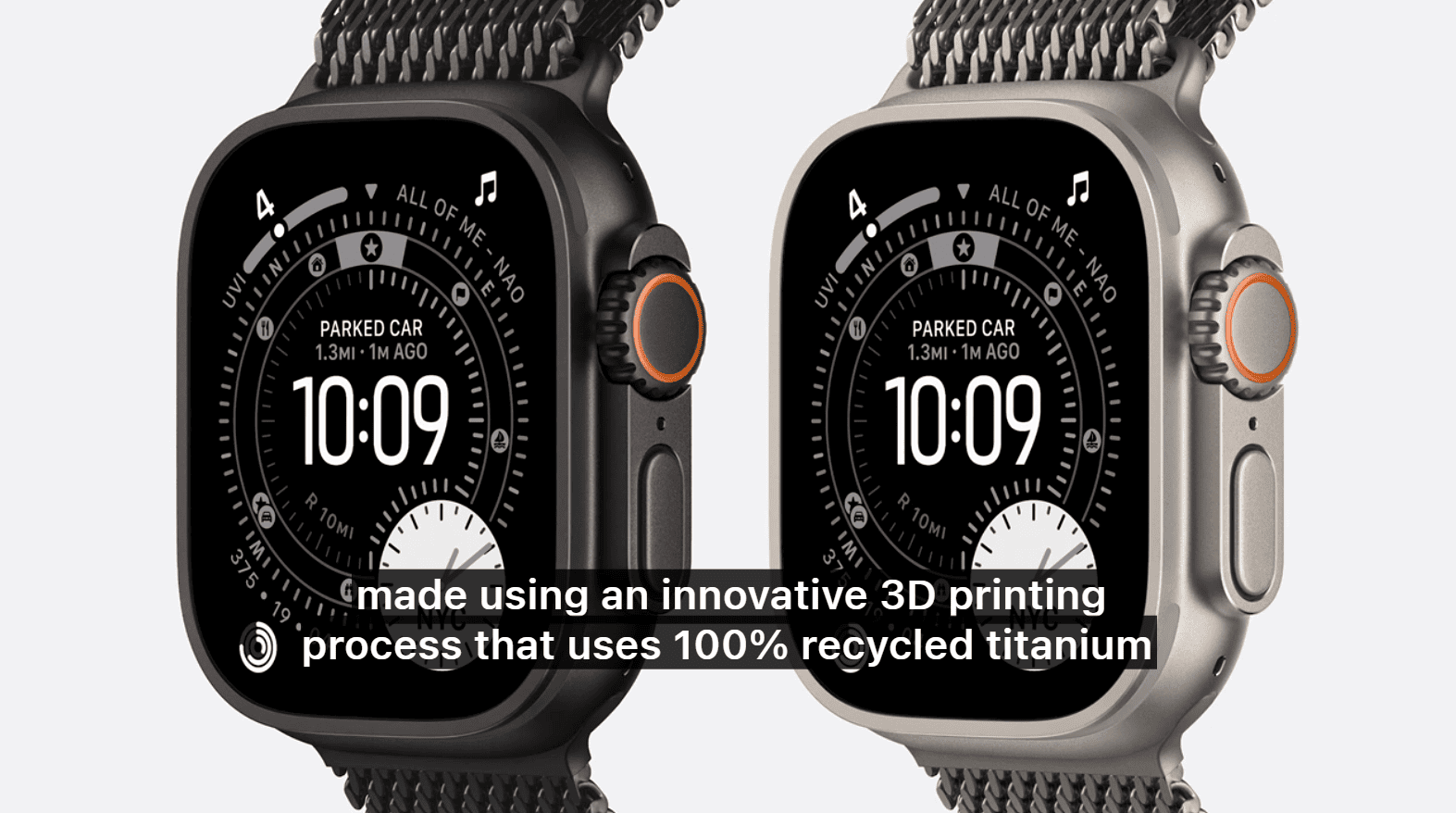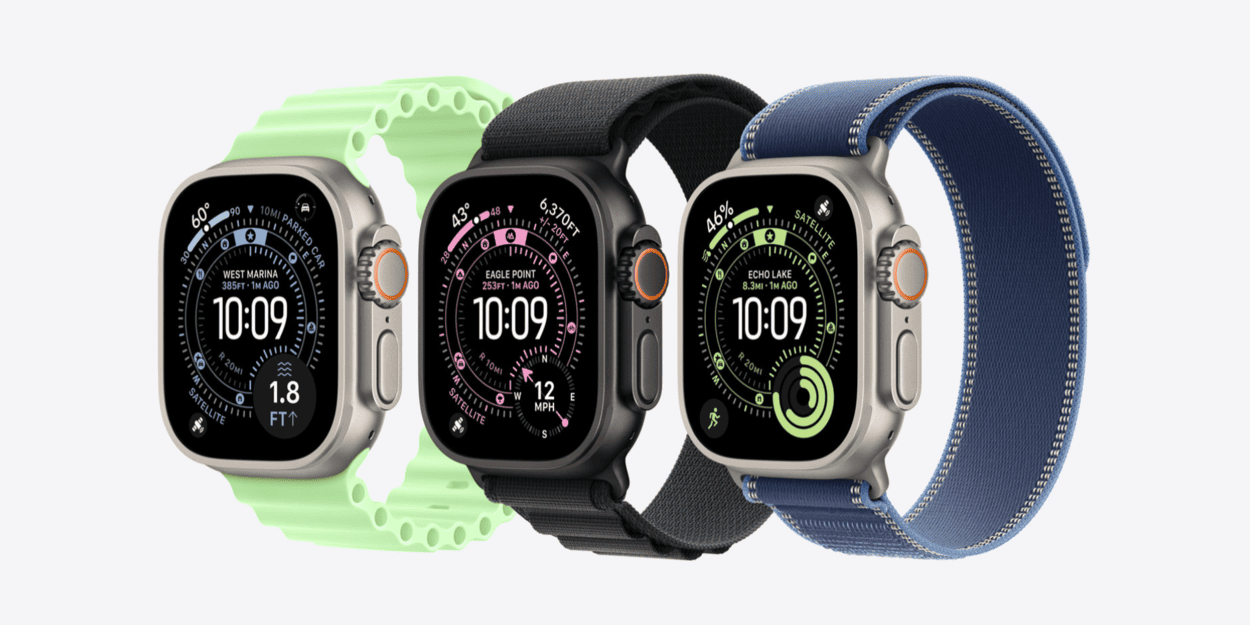Banner Image Courtesy of Apple
Apple Watch Ultra 3 announcement put titanium and additive manufacturing in the spotlight: Apple says the Ultra 3 case uses 100% recycled titanium and an innovative 3D printing process. That’s an industry signal, not a how-to, but it’s a great launching point for makers and small brands who want to use titanium 3D printing to build premium consumer products.
Why Titanium for Premium Wearables?
Titanium shows up in premium watches, medical devices, and aerospace parts for good reasons that map directly to wearable product needs:
1. Strength-to-weight: titanium alloys (and especially Ti-6Al-4V) deliver high strength at much lower density than steel, letting you make rigid, thin parts that stay light on the wrist.
2. Corrosion resistance & biocompatibility: titanium forms a stable oxide layer that resists sweat and salt, and it’s widely accepted for skin contact.
3. Premium finish potential: When properly finished, titanium has a muted, luxury look that reads high-end.
4. Sustainability story: recycled titanium and powder-efficient 3D printing workflows reduce scrap and raw-material demand.
For designers, that means you can target thinner walls, more aggressive topology optimization, and part consolidation (fewer assembled pieces) without sacrificing stiffness. The tradeoff is process complexity and finishing time, but when the goal is premium, the benefits usually outweigh the costs.

Image Courtesy of Apple
How Titanium 3D Printing Really Works?
The dominant metal 3D printing method for titanium is laser powder bed fusion (LPBF), often called SLM or DMLS. LPBF lays a thin layer of metal powder, then melts it selectively with a high-power laser; the bed drops, and the cycle repeats until the part is built. LPBF is famous for its geometric freedom, high detail, and surface finish that’s suitable for precision parts after post-processing.
Other metal 3D printing methods include electron beam melting (EBM) and directed energy deposition (DED). EBM operates in a vacuum with an electron beam; it can be faster for large builds and is well-suited to titanium alloys, but typically yields a rougher surface and slightly different microstructure. DED is ideal for larger repairs and near-net shapes but has lower detail than LPBF. Choosing between LPBF and EBM often comes down to the surface/accuracy you need, build speed, and machine availability.
Properties of 3D Printed Titanium
Mechanical Behavior
SLM 3D printed Ti-6Al-4V typically shows high tensile strength and can achieve mechanical performance comparable to or better than some wrought materials after proper post-processing (heat treatments, HIP). That said, as-printed parts can be more brittle and show anisotropy because of the rapid thermal cycles and directional microstructure. Heat treatment and HIP are common to improve ductility and fatigue life.
Surface and Microstructure
Raw printed surfaces are rougher than machined or forged parts and often exhibit visible layer texture, partially melted particles, and small process pores. Surface roughness and any internal porosity are the main drivers of fatigue life and cosmetic quality, both are addressed in post-processing.
Dimensional Stability and Tolerances
Expect tighter dimensional control on machined faces and critical registers; designers commonly leave datums to be machined after printing, or specify post-process machining for press-fits, threads, and sealing surfaces.
Common Titanium Grades for 3D Printing
Two practical categories dominate wearable applications:
• CP-Ti (Grades 1–4): commercially pure titanium variants with excellent corrosion resistance and good biocompatibility. They’re softer and easier to finish to a satin look; useful for direct skin contact parts where extreme strength isn’t required.
• Ti-6Al-4V (Grade 5): the most widely used alloy in metal 3D printing. It offers a great strength-to-weight balance and is well-understood for LPBF and EBM processes. It’s typically chosen for structural components, clamps, and parts that must resist mechanical loading.
Designers should pick CP-Ti when surface hue and softness matter and Ti-6Al-4V when strength and fatigue resistance are priorities. Powder traceability, certification, and recycled-content claims also influence grade selection — particularly for regulated or safety-sensitive products.
Post-processing & Surface Finishing
1. Support Removal and Basic Machining
Cut away supports and machine critical faces and datums (mating surfaces, screw bosses, sealing grooves). Machining yields tight tolerances for assembly.
2. Stress Relief and Heat treatment / HIP
Stress-relief anneals and Hot Isostatic Pressing (HIP) collapse internal pores and dramatically improve density, fatigue life, and ductility — a standard step for load-bearing titanium parts.
3. Surface Preparation
Bead blasting or tumbling removes powder peening and reduces macro-roughness; grit choice influences the final texture. Ceramic or glass beads are common for watch parts.
4. Polishing / Electropolishing
Mechanical polishing (buffing, vibratory polishing) or electropolishing smooths the surface toward satin or mirror finishes. Electropolishing can preferentially remove peaks and improve micro-roughness on complex geometries.
5. Coatings & Coloration
PVD or DLC coatings add wear resistance and color; anodic coloring produces hue changes on CP-Ti in some controlled processes (note: anodizing titanium differs from aluminum and has limits). PVD gives consistent, premium results for bezels and trims.
6. Final Inspection and Sealing Tests
Dimensional inspection, dye penetrant or CT for defects, and water-seal testing (for wearables) close the loop.
Hi3DP: Low-Cost Titanium 3D Printing for Your New Project
If you’re exploring titanium prototypes or a small production run, Hi3DP is a cost-effective partner across the full chain, from powder selection to finished, ready-to-assemble parts.
We have:
• Material Grade: Ti-6Al-4V available.
• High-Quality Titanium Parts: industrial SLM 3D printers.
• Full-Chain Post-processing: support removal, CNC machining of critical faces, stress relief and HIP, bead blasting, electropolishing, and PVD coating, all under one roof to cut handling time.
• Prototype-Friendly Pricing: sample runs and scaled quotation models, prototype-first pricing with transparent costs.
• How to get started: upload your 3D files to our instant quotation platform, select Ti-6Al-4V material and choose your preferred surface finishing. You will get a quote in a few seconds!














